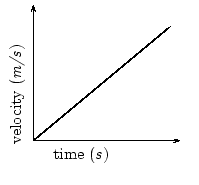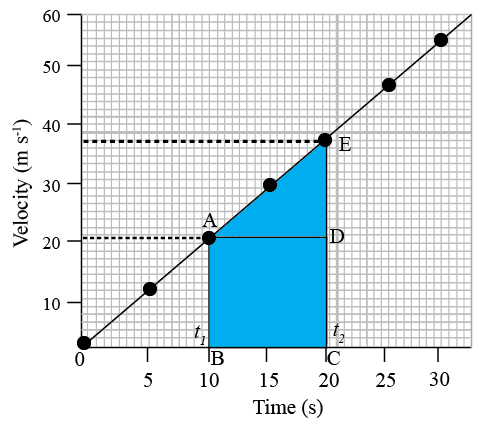9th Grade > Physics
MOTION MCQs
Total Questions : 58
| Page 1 of 6 pages
Answer: Option A. -> u+v2
:
A

Given, speed of the auto during the first half of the journey is u and the next half of the journey is v
Let total time taken for the journey be T
∴Time taken for the first half of the journey be T2 and the next half of the journey be T2
Let the average speed be Vav
We know, speed=Distancetime
∴ Distance=speed×time
During the first half of the journey, distance, d1=u×T2
During the second half of the journey, distance, d2=v×T2
Total distance =d=d1+d2
=u×T2+v×T2
⇒d=T2(u+v)
Average speed,Vav =TotaldistanceTotaltimetaken
=dT
=T2(u+v)T
=u+v2
:
A

Given, speed of the auto during the first half of the journey is u and the next half of the journey is v
Let total time taken for the journey be T
∴Time taken for the first half of the journey be T2 and the next half of the journey be T2
Let the average speed be Vav
We know, speed=Distancetime
∴ Distance=speed×time
During the first half of the journey, distance, d1=u×T2
During the second half of the journey, distance, d2=v×T2
Total distance =d=d1+d2
=u×T2+v×T2
⇒d=T2(u+v)
Average speed,Vav =TotaldistanceTotaltimetaken
=dT
=T2(u+v)T
=u+v2
Answer: Option D. -> Straight line inclined at some angle with respect to time axis
:
D

Since acceleration is constant, the slope of thevelocity-time graph should be a straight line withconstant slope. Thus, the graph whichshows a straight line inclined at some anglewith respect to time axisrepresents the velocity-time graph of a body with a constant acceleration.
:
D

Since acceleration is constant, the slope of thevelocity-time graph should be a straight line withconstant slope. Thus, the graph whichshows a straight line inclined at some anglewith respect to time axisrepresents the velocity-time graph of a body with a constant acceleration.
Answer: Option C. -> 1099 kmph
:
C
Given, the radius of the orbit, R=4200km
The time taken to revolve around the Earth, T=24hr(1day)
The speed of the satellite, v=Circumference of the orbitTime taken
=2πRT
=2×3.14×4200km24hr
=1099kmhr−1
=1099kmph
:
C
Given, the radius of the orbit, R=4200km
The time taken to revolve around the Earth, T=24hr(1day)
The speed of the satellite, v=Circumference of the orbitTime taken
=2πRT
=2×3.14×4200km24hr
=1099kmhr−1
=1099kmph
Answer: Option C. -> 1.11 ms−2
:
C
Initial speed, u=80kmph= 80×100060×60=80036ms−1
Final speed, v=60kmph= 60×100060×60=60036ms−1
Time taken t=5s
From the first equation of motion,
a=v−ut =600−80036×5=−1.11ms−2.
Here sign of acceleration is negative which shows that the speed is decreasing and acceleration is in the opposite direction of the motion.
:
C
Initial speed, u=80kmph= 80×100060×60=80036ms−1
Final speed, v=60kmph= 60×100060×60=60036ms−1
Time taken t=5s
From the first equation of motion,
a=v−ut =600−80036×5=−1.11ms−2.
Here sign of acceleration is negative which shows that the speed is decreasing and acceleration is in the opposite direction of the motion.
Answer: Option C. -> Speed remains constant and velocity changes continuously.
:
C
In a uniform circular motion, the speedremains constant. However, the direction of the body keeps changing. This is due toan acceleration that is perpendicular to the direction of velocity at every point.Hence,the velocity does not remain constant.
:
C
In a uniform circular motion, the speedremains constant. However, the direction of the body keeps changing. This is due toan acceleration that is perpendicular to the direction of velocity at every point.Hence,the velocity does not remain constant.
Answer: Option D. -> 15 ms−1
:
D
Given, distance travelled by the car =300m and the time taken =20s.
We know, speed=distancetime
⇒speed=30020 = 15ms−1.
∴ Speed of car is 15ms−1
:
D
Given, distance travelled by the car =300m and the time taken =20s.
We know, speed=distancetime
⇒speed=30020 = 15ms−1.
∴ Speed of car is 15ms−1
Answer: Option D. -> s=1.25 m, t=0.5 s
:
D
Given, initial velocity, u=5ms−1, acceleration, a=−10ms−2.
Let 'v' be the final velocity and 's' be the height attained.
At the highest point of motion, v=0
Using third equation of motion, v2=u2+2as,
0=52+[2×(−10)×s]
⇒s=1.25m
Hence the height attained by the coin is 1.25m.
Let the time taken be t.
Using the first equationof motion,
v=u+at
0=5−10t
⇒t=0.5s
∴ Time taken by the coin is 0.5s.
:
D
Given, initial velocity, u=5ms−1, acceleration, a=−10ms−2.
Let 'v' be the final velocity and 's' be the height attained.
At the highest point of motion, v=0
Using third equation of motion, v2=u2+2as,
0=52+[2×(−10)×s]
⇒s=1.25m
Hence the height attained by the coin is 1.25m.
Let the time taken be t.
Using the first equationof motion,
v=u+at
0=5−10t
⇒t=0.5s
∴ Time taken by the coin is 0.5s.
Answer: Option C. -> 12 ms−1, 50 s
:
C
Given:
Length of the train, D=60m,
Time taken to cross the pole, T=5s,
Length of the bridge =540m
Speed of the train, s=DT
Speed of the train, s=605=12ms−1
Now, distance to be covered to cross a 540m long bridge is sum of Length of the train and Length of the bridge.
d=60+540=600m
∴Time taken=ds
Time taken=60012=50s
∴Speed of thetrain is 12ms−1 and the time it will take to cross the bridge is 50s.
:
C
Given:
Length of the train, D=60m,
Time taken to cross the pole, T=5s,
Length of the bridge =540m
Speed of the train, s=DT
Speed of the train, s=605=12ms−1
Now, distance to be covered to cross a 540m long bridge is sum of Length of the train and Length of the bridge.
d=60+540=600m
∴Time taken=ds
Time taken=60012=50s
∴Speed of thetrain is 12ms−1 and the time it will take to cross the bridge is 50s.
Answer: Option B. -> uniform circular motion
:
B
The motion of a satellite in a circular orbit is uniform circular motion.In uniform circular motion, a body moves in a circle with constant speed butthe velocity changes due to a constant change in direction.
:
B
The motion of a satellite in a circular orbit is uniform circular motion.In uniform circular motion, a body moves in a circle with constant speed butthe velocity changes due to a constant change in direction.

















